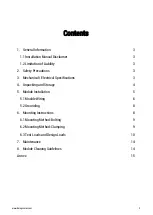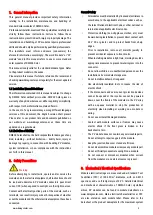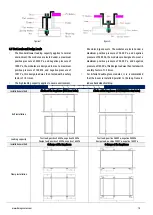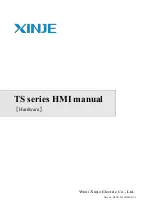
DMEGC Solar PV Modules Installation Manual
the voltage specifications of the inverters used in the
system. In addition, modules must not be connected
together to create a voltage higher than the maximum
permitted system voltage stated on the module
nameplate, even under the worst local temperature
conditions (see Table 1 for the correction coefficients
that apply to open-circuit voltage).
•
A maximum of two strings can be connected in parallel
without using an over-current protection device (fuses,
etc.) incorporated in series within each string. Three or
more strings can be connected in parallel if an
appropriate and certified over-current protection device
is installed in series within each string. And it shall be
ensured in the PV system design that the reverse current
of any particular string is lower than the module
maximum fuse rating at any circumstances.
•
Only modules with similar electrical parameters should be
connected in the same string to avoid or minimize
mismatch effects in arrays.
•
To minimize risk in the event of an indirect lightning strike,
avoid forming loops with the wiring when designing the
system.
•
The recommended maximum series fuse rating is stated
in the module datasheets.
•
Modules should be safely fixed to bear all expected loads,
including wind and snow loads.
•
A minimum clearance of 6.5 mm (0.25 in) between
modules is required to allow for thermal expansion of the
frames.
•
The small drainage holes on the underside of the module
must not be blocked.
Optimum Orientation and Tilt
•
To maximize the annual yield, please calculate the
optimum orientation and tilt for PV modules in that
specific installation site. The highest yields are achieved
when sunlight shines perpendicularly onto the PV
modules.
Avoid Shading
•
Modules shall not be permanently shaded (including
partial shading, spot shading, even shading or uneven
shading) under any circumstance. Permanent shading
includes shading of the same cell, cell row, or module
portion for extended and repeated periods of time (e.g.
more than 200 daylight hours over the warrantied service
lifetime). Power dissipated in fully or partially shaded
cells will result in power loss, reduced yield and can cause
localized overheating, which in turn may negatively
impact the module service lifetime. Permanent shading
may cause accelerated ageing of the encapsulation
material and place thermal stress on the bypass diodes.
This would void the module’s warranty u
nless properly
mitigated through the use of Module Level Power
Electronic (MLPE) devices.
•
Regular maintenance is required to keep modules clean.
Particular measures should be taken to avoid permanent
shading from dirt or debris (e.g., plants, bird droppings,
etc).
•
Do not install modules directly behind any object (e.g.,
tree, antenna, etc) to prevent occurrence of permanent
shading.
•
Even temporary partial shading will reduce the energy
yield. A module can be considered to be unshaded if its
entire surface is free from shading all year round,
including on the shortest day of the year.
Reliable Ventilation
•
Sufficient clearance (at least 100 mm (3.94 in)) between
the module frame and the mounting surface is required to
allow cooling air to circulate around the back of the
module. This also allows condensation or moisture to
dissipate.
•
According to IEC 61730, any other specific clearance
required for maintaining a system fire rating should
prevail. Detailed clearance requirements pertaining to
system fire ratings must be provided by your racking
supplier.
5.1 Module Wiring
Correct Wiring Scheme
•
Cable management scheme should be reviewed and
approved by the EPC contractor; in particular required
cable lengths should be cross-checked considering the
specificities of the tracker structure like bearing house
gaps. If longer cable or additional jumper cables are
requested, please contact DMEGC So
lar’s sales
representative in advance.
•
Ensure that the wiring is correct before starting up the
system. If the measured open circuit voltage (Voc) and
short-circuit current (Isc) differ from the specifications,
this indicates that there is a wiring fault.


































